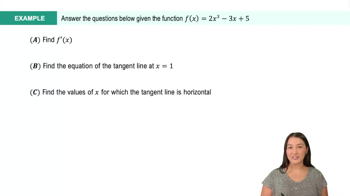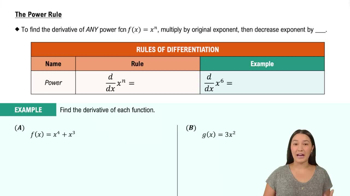Table of contents
- 0. Functions7h 52m
- Introduction to Functions16m
- Piecewise Functions10m
- Properties of Functions9m
- Common Functions1h 8m
- Transformations5m
- Combining Functions27m
- Exponent rules32m
- Exponential Functions28m
- Logarithmic Functions24m
- Properties of Logarithms34m
- Exponential & Logarithmic Equations35m
- Introduction to Trigonometric Functions38m
- Graphs of Trigonometric Functions44m
- Trigonometric Identities47m
- Inverse Trigonometric Functions48m
- 1. Limits and Continuity2h 2m
- 2. Intro to Derivatives1h 33m
- 3. Techniques of Differentiation3h 18m
- 4. Applications of Derivatives2h 38m
- 5. Graphical Applications of Derivatives6h 2m
- 6. Derivatives of Inverse, Exponential, & Logarithmic Functions2h 37m
- 7. Antiderivatives & Indefinite Integrals1h 26m
- 8. Definite Integrals4h 44m
- 9. Graphical Applications of Integrals2h 27m
- 10. Physics Applications of Integrals 2h 22m
3. Techniques of Differentiation
Basic Rules of Differentiation
Problem 3.45
Textbook Question
Derivative calculations Evaluate the derivative of the following functions at the given point.
f(s) = 2√s-1; a=25
 Verified step by step guidance
Verified step by step guidance1
Step 1: Identify the function and the point at which you need to evaluate the derivative. The function is \( f(s) = 2\sqrt{s} - 1 \) and the point is \( a = 25 \).
Step 2: Rewrite the function in a form that is easier to differentiate. Express \( \sqrt{s} \) as \( s^{1/2} \). Thus, the function becomes \( f(s) = 2s^{1/2} - 1 \).
Step 3: Differentiate the function using the power rule. The power rule states that \( \frac{d}{ds}[s^n] = ns^{n-1} \). Apply this to \( 2s^{1/2} \) to find \( f'(s) \).
Step 4: Calculate the derivative \( f'(s) \). Using the power rule, \( f'(s) = 2 \cdot \frac{1}{2}s^{-1/2} = s^{-1/2} \).
Step 5: Evaluate the derivative at \( s = 25 \). Substitute \( s = 25 \) into \( f'(s) = s^{-1/2} \) to find \( f'(25) \).
 Verified video answer for a similar problem:
Verified video answer for a similar problem:This video solution was recommended by our tutors as helpful for the problem above
Video duration:
2mPlay a video:
Was this helpful?
Key Concepts
Here are the essential concepts you must grasp in order to answer the question correctly.
Derivative
The derivative of a function measures how the function's output value changes as its input value changes. It is defined as the limit of the average rate of change of the function over an interval as the interval approaches zero. In practical terms, the derivative at a point gives the slope of the tangent line to the function's graph at that point.
Recommended video:

Derivatives
Chain Rule
The chain rule is a fundamental technique in calculus used to differentiate composite functions. It states that if a function is composed of two functions, say f(g(x)), the derivative can be found by multiplying the derivative of the outer function f with the derivative of the inner function g. This rule is essential when dealing with functions that involve nested expressions.
Recommended video:

Intro to the Chain Rule
Square Root Function
The square root function, denoted as √s, is a specific type of function that returns the non-negative value whose square is s. When differentiating functions involving square roots, it is important to apply the power rule appropriately, as √s can be rewritten as s^(1/2). Understanding how to manipulate and differentiate square root functions is crucial for solving problems involving them.
Recommended video:

Multiplying & Dividing Functions

 3:59m
3:59mWatch next
Master Derivatives of Linear Functions with a bite sized video explanation from Callie
Start learningRelated Videos
Related Practice







